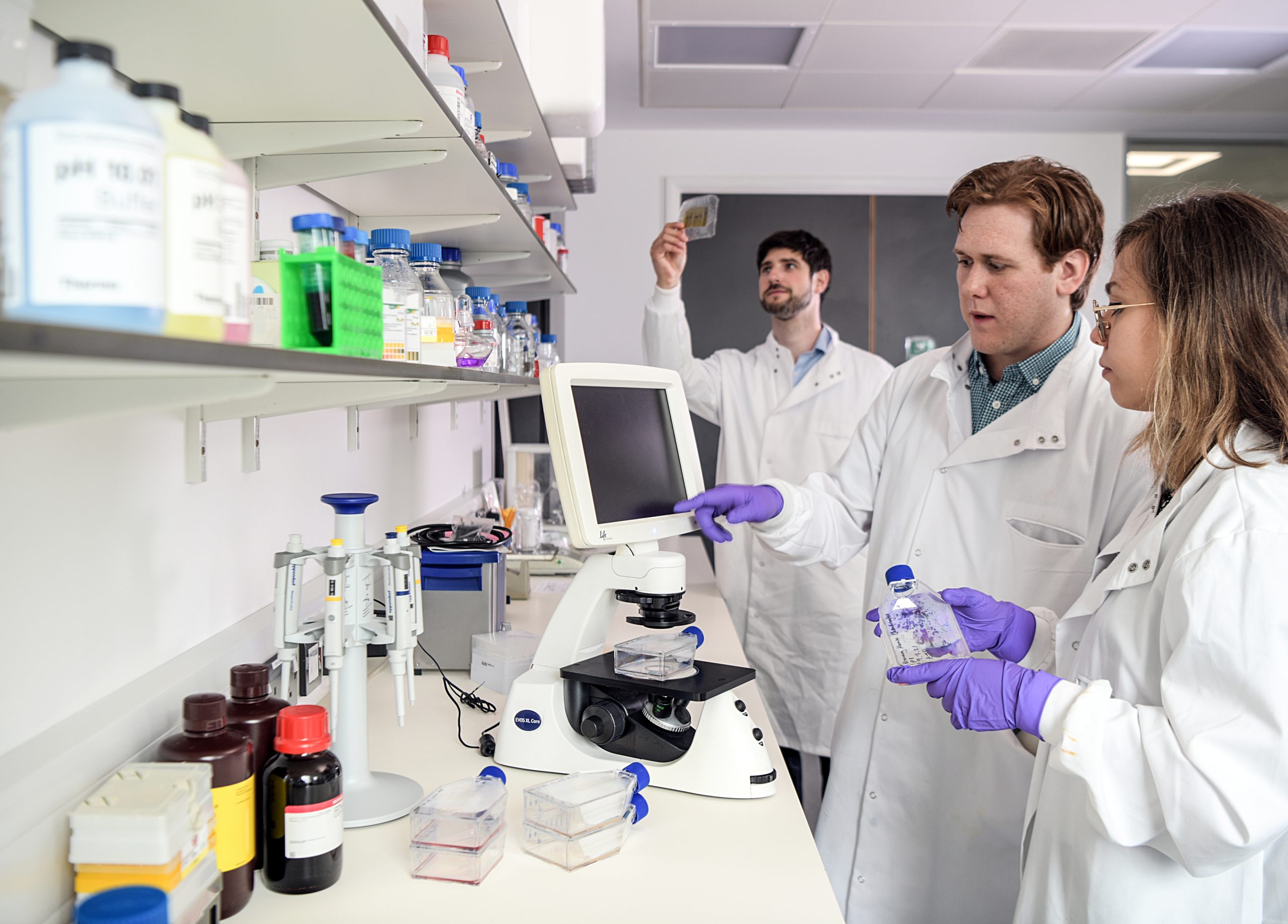Secretomix® represents a potential paradigm shift in regenerative medicine. Through its ability to simultaneously act on numerous cell signalling pathways, Micregen aims to provide an ideal approach for the treatment of multiple hallmarks of ageing.
A stem cell’s ability to self-renew and differentiate offers the potential to regenerate and repair tissues. However, there were four significant challenges.
- The first challenge we faced when considering stem cell treatment was understanding how stem cells function in the injured microenvironment. We identified these mechanisms and are now translating our preclinical findings to human studies (Mellows, Mitchell et al. 2017, Mitchell, Mellows et al. 2019).
- The second challenge was identifying and isolating the key regenerative factors that Secretomix® use to induce repair and regeneration and then optimise production of these factors to create a scalable product.
- The next challenge was avoiding immune rejection. Secretomix® escape immunological rejection partly because they derive from developmentally naïve and immunologically privileged stem cells while bypassing the need for whole-cell transplants. This creates a treatment that most people can use, rather than one only used by the donor. In addition, this means that Secretomix® can be administered immediately at the point of care for multiple recipients with minimal immunological risk.
- Proprietary manufacturing processes and a developed allogeneic cell line enabled Micregen to overcome the final challenge of scaling up the production of Secretomix® to provide a cost-effective therapy that the majority can use and the starting material for a variety of degenerative diseases for years to come.
Micregen’s intellectual property continues to build around its novel platform technology that overcomes these challenges and, if successful in human trials, will offer significant manufacturing and clinical advantages.

This short video represents the potential for Micregen’s Secretomix® to home into target tissues and release its repairing cargo. The video shows the paracrine factors labelled with a fluorescent dye penetrating a target cell.
Location of the labelled extracellular vesicles was determined by taking optical slices through confocal microscopy. Optical slices were aligned to generate a 3-D image which shows the nuclei in blue surrounded by the cytoplasm in brown. Bright speckles in the cytoplasm show the location of individual extracellular vesicles.
Secretomix® are cell-free biologics of stem cell origin.
Whole stem cell therapies have shown significant benefits across various diseases and illnesses.
However, research shows that despite the benefits of whole cell-based therapies, the proportion of cells that engraft into damaged tissue (the expected mechanism of action) is dramatically lower than the number of whole stem cells introduced due to their entrapment in the tiny blood vessels of the lungs and liver in particular (Fischer, Harting et al. 2009).
The many beneficial effects found in whole stem cell therapies have since been discovered to come from the paracrine factors secreted from the cells rather than the whole cells themselves.
The use of Secretomix® is aimed to facilitate tissue repair, modulate inflammation and scarring, activate resident stem cells, improve blood flow, and generate a pro-regenerative microenvironment across a wide range of organs and tissue types. Micregen believes their innovative approach can change how multiple critical and chronic problems are managed.
Micregen’s Intellectual Property revolves around utilising its unique clinical grade cell line and platform technology to develop, optimise, and manufacture Micregen’s stem cell-derived, cell-free secretome therapeutics (“Secretomix®”).
The overarching goal and aim are to substantially improve patients’ health and well-being.
The use of Secretomix® is aimed to facilitate tissue repair, modulate inflammation and scarring, improve blood flow and tissue perfusion, and thus generate a pro-regenerative microenvironment across a wide range of organ and tissue damage.
Micregen believes their innovative approach can change how multiple acute and chronic problems are managed.
As a cell-free approach, the use of Secretomix® negates the need to introduce whole stem cells into the patient. Therefore, the risk of potential uncontrolled differentiation or tumour development from the use of whole cells is reduced, making a significant advance to patient safety (Zhang, Gao et al. 2019, Wu, Wang et al. 2022).
These discoveries will enable Micregen to overcome such barriers to translating stem cell derived technology into many areas of medicine.
In recent years there has been an exponential growth in peer-reviewed, published scientific papers confirming Micregen’s approach. (Gnecchi, Zhang et al. 2008, Ranganath, Levy et al. 2012, Lener, Gimona et al. 2015, Ho, Warr et al. 2017, Phinney and Pittenger 2017).
Micregen is currently undertaking several studies to identify the efficacious effects of Secretomix® to tackle degeneration and the effects of ageing in its many guises.

The principal modes of action of stem cell secretomes are:
- Modulation of inflammation
- Decreased cellular senescence
- Activation of resident stem cell and tissue-specific progenitor cell populations
- Improved angiogenesis – enhanced blood flow
- Anti-apoptotic and chemotactic signalling
- Beneficial remodelling of the extracellular matrix
- Regulation of protein catabolism and anabolism
- Reduced mitochondrial dysfunction
- Protection of cells from oxidative stress.
Micregen aims to utilise its Secretomix® platform technology to target the hallmarks of ageing and treat the root cause of age-related illness as opposed to the symptoms. Thus, increasing health span and prolonging the period of life that can be actively lived.
